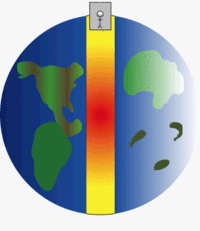Gravity train

A gravity train is a theoretical means of transportation intended to go between two points on the surface of a sphere, following a straight tunnel that goes directly from one point to the other through the interior of the sphere.
In a large body such as a planet, this train could be left to accelerate using just the force of gravity, since, during the first half of the trip (from the point of departure until the middle), the downwards pull towards the center of gravity would pull it towards the destination. During the second half of the trip, the acceleration would be in the opposite direction relative to the trajectory, but (ignoring the effects of friction) the speed acquired before would be enough to cancel this deceleration exactly (so that the train would reach its destination with speed equal to zero).[1]
Objections
In reality, there are two reasons gravity trains do not exist. First, the transit shown in the illustration would pierce the Earth's mantle and traverse a region where rock is more fluid than solid. No materials are known that would withstand the tremendous heat and pressure in the inner core. Temperature is estimated as 5,700 K (5,430 °C; 9,800 °F), and pressure as high as about 330 to 360 gigapascals (3,300,000 to 3,600,000 atm). Secondly, frictional losses would be significant. Rolling friction losses could be reduced by using a magnetically levitated train. However, unless all air is evacuated from the tunnel, frictional losses due to air resistance would render the gravity train unusable. Evacuating the atmosphere to make it a vactrain would eliminate this drag but would require additional power. Such objections would not apply for solid planets and moons that do not have an atmosphere.
Origin of the concept
In the 17th century, British scientist Robert Hooke presented the idea of an object accelerating inside a planet in a letter to Isaac Newton. A gravity train project was seriously presented to the Paris Academy of Sciences in the 19th century. The same idea was proposed, without calculation, by Lewis Carroll in 1893 in Sylvie and Bruno Concluded. The idea was rediscovered in the 1960s when physicist Paul Cooper published a paper in the American Journal of Physics suggesting that gravity trains be considered for a future transportation project.[2]
Mathematical considerations
Under the assumption of a spherical planet with uniform density, and ignoring relativistic effects as well as friction, a gravity train has the following properties:[3]
- The time of a trip depends only on the density of the planet and the gravitational constant, but not on the diameter of the planet.
- The maximum speed is reached at the middle point of the trajectory.
For gravity trains between points which are not the antipodes of each other, the following hold:
- The shortest time tunnel through a homogeneous earth is a hypocycloid; in the special case of two antipodal points, the hypocycloid degenerates to a straight line.
- All straight-line gravity trains on a given planet take exactly the same amount of time to complete a journey (that is, no matter where on the surface the two endpoints of its trajectory are located).
On the planet Earth specifically, a gravity train has the following parameters:
- The travel time equals 2530.30 seconds (nearly 42.2 minutes), assuming Earth were a perfect sphere of uniform density.
- For a train that goes directly through the center of the Earth, the maximum speed is about 7,900 metres per second (28440 km/h).
In fiction
In the 2012 movie Total Recall, a gravity train is used to commute between Western Europe and Australia. In Super Mario Galaxy, there are a few holes that work to this effect.
See also
References
- ↑ Newton, Isaac. Philosophiæ Naturalis Principia Mathematica,.
- ↑ "To Everywhere in 42 Minutes".
- ↑ Robin Davis: A Physicist's Pipe Dream
- Description of the concept Gravity train and mathematical solution (Alexandre Eremenko web page at Purdue University).
- Translations of the previous page into Romanian and Polish.
- The Amazing 42-Minute Gravity Sled, at the Hitch-Hiker's Guide to the Galaxy website.
External links
- A Java simulation of this motion; includes tunnels that do not pass through the center of the earth. Also shows a satellite with same period.
- The Gravity Express
- To Everywhere in 42 Minutes
- The fictitious Alameda Weehawken Burrito Tunnel is a gravity train.
- Wolfram Alpha: The Science of Total Recall